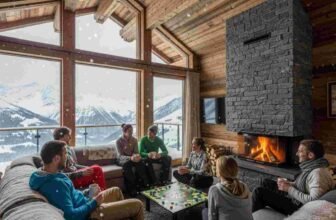
Ever dreamed of living in a home that not only feels like a sanctuary but also gives back to the planet? I know I have. The idea of sustainable living, where you can reduce your carbon footprint and still enjoy all the comforts of home, is more than just a trend—it’s a movement that’s changing the world.
And the best part? There are amazing places out there that make it easier and more affordable to build your dream green home. These countries are offering incredible tax credits and incentives that can cut your costs in half.
Trust me, once you see what they have to offer, you’ll be itching to pack your bags and start your eco-friendly adventure. Let’s dive in and explore the possibilities together!
1. United States

The 45L Tax Credit is a game-changer, offering up to $5,000 per unit for energy-efficient homes that meet specific standards like Energy Star or Zero Energy Ready Home. Thanks to the Inflation Reduction Act, this credit now applies to more projects, including multifamily buildings of any size. Then there’s the 179D Tax Deduction, which provides up to $5.65 per square foot for energy-efficient commercial and tax-exempt buildings.
These incentives not only reduce the upfront costs of green building but also promote the use of renewable resources and lower greenhouse gas emissions. The Residential Clean Energy Credit is another fantastic benefit, covering 30% of the cost of installing renewable energy systems like solar panels, wind turbines, and geothermal heat pumps.
It’s valid through 2032, so there’s plenty of time to take advantage of it. These tax credits make building green homes not only environmentally friendly but also economically viable. So, if you’re considering constructing a sustainable home in the U.S., you’re in luck!
Other Relevant Information
Notable Green Building Projects: The Bullitt Center in Seattle is a prime example of how these incentives can be leveraged to create highly energy-efficient buildings. It maximizes natural daylight and incorporates advanced insulation, reducing energy consumption and qualifying for significant tax benefits.
2. Germany

Germany is a powerhouse when it comes to promoting green home building through tax credits. The German government has implemented various incentives to encourage sustainable construction practices. One of the key benefits is the KfW Efficiency House program, which provides low-interest loans and grants to homeowners and builders who construct or renovate homes to meet high energy efficiency standards. These financial incentives can cover a significant portion of the costs associated with green building projects. Additionally, Germany offers tax deductions for energy-efficient renovations, allowing homeowners to reduce their tax burden while improving the energy performance of their homes. The country’s strong commitment to environmental protection and sustainability is reflected in these policies, making it an attractive destination for those looking to build green homes. The emphasis on renewable energy and energy efficiency in German buildings not only helps combat climate change but also creates a healthier living environment for residents.
Green Building Certifications: DGNB (German Sustainable Building Council) certification is highly regarded and can enhance the value and marketability of green buildings.
3. Singapore

Singapore is a global leader in green building initiatives, and its tax credits for green home builders are no exception. The city-state offers generous grants that cover up to 50 percent of installation costs for green roofs and vertical gardens through its Skyrise Greenery Initiative. This financial support has led to the establishment of 155 hectares (1.55 million m²) of green roofs in just a few years. Property developers can also receive additional floor area allowances when incorporating green roofs into their projects, making them more attractive from a business perspective. These policies have encouraged widespread adoption of green roofs across Singapore. The government’s proactive approach to promoting sustainable living and its commitment to reducing carbon emissions make it an excellent choice for green home builders seeking substantial tax incentives and support.
Other Relevant Information
- Best Months to Visit: February to April and September to November offer relatively cooler weather and fewer chances of rain.
- Green Building Projects: Marina Bay Sands is an iconic example of Singapore’s green building efforts, featuring extensive green roofs and sustainable design elements.
4. Switzerland

Switzerland stands out as a top country for green home builders due to its robust tax credit programs. The Swiss government provides funding to help businesses and homeowners adopt green roofs. For instance, the city of Basel has required all new flat roofs to be green for over a decade, resulting in 46 percent of flat roofs being vegetated. This has made green roofs almost a building standard in Switzerland. The country’s commitment to sustainable development is evident in its policies and incentives, which encourage the use of eco-friendly materials and energy-efficient systems in construction. By offering financial support for green building projects, Switzerland not only reduces the environmental impact of buildings but also creates a more sustainable and healthier living environment for its residents.
Other Relevant Information
- Best Months to Visit: June to August for outdoor activities and December for winter sports and Christmas markets.
- Green Building Standards: Swisspearl is a well-known certification for sustainable buildings in Switzerland.
5. Netherlands

The Netherlands is another country that offers significant tax credits for green home builders. Local municipalities provide financial support that covers a substantial portion of installation costs for green roofs. For example, Amsterdam started offering a 50 percent incentive to install green roofs in 2009 and now has more than 120,000 m² of green roofs across the city. Some municipalities also offer tax deductions for property owners who install green roofs. These incentives have encouraged businesses to integrate green roofs into their buildings, leading to reduced energy consumption and increased property values. The Dutch government’s proactive stance on green infrastructure and its commitment to sustainable urban development make it an attractive destination for green home builders seeking financial incentives and support.
Other Relevant Information
- Best Months to Visit: May to September offer pleasant weather and beautiful blooming flowers.
- Green Building Initiatives: The Green Wall in Almere is a notable example of the Netherlands’ green building initiatives.
6. Denmark

Alright, let’s dive into Denmark. This Scandinavian gem has a knack for blending eco-friendly practices with tax benefits. The Danish government understands the value of green roofs and offers subsidies that can cover up to 50 percent of installation costs. It’s like getting a helping hand to make your building more sustainable. In 2020 and 2021 alone, these subsidies led to the installation of approximately 200,000 m² of green roofs. The government’s goal is to increase this by 25 percent each year. By 2025, they aim to have green roofs covering 600,000 m². This commitment shows Denmark’s dedication to sustainable building practices. So, if you’re looking to build a green home in Denmark, you’ll likely find the support you need through these tax credits.
Other Relevant Information
- Best Months to Visit: June to August for long days and outdoor activities.
- Green Building Projects: Copenhagen’s Circle Bridge is an example of innovative green design, featuring lush green roofs and sustainable construction methods.
7. France

Ah, France! It’s not just about romance and baguettes. The French government has a pretty sweet deal for green home builders with its MaPrimeRénov program. This initiative offers financial assistance for energy-efficient renovations. The program has a budget of €35 billion, with a staggering €16.9 billion allocated for 2023. That’s a lot of dough to help make your home greener! The aid varies depending on your income. Low-income households can receive up to €30,000 (€40,000 for households in thermal emergency areas), while moderate-income households can get up to €22,500. Plus, there’s a fixed aid of €5,000 for other households. This financial boost can make energy-efficient upgrades more affordable and accessible. So, building a green home in France could be financially rewarding and beneficial for the environment.
Other Relevant Information
- Best Months to Visit: April to June and September to October offer pleasant weather and fewer crowds in tourist areas.
- Green Building Certifications: HQE (Haute Qualité Environnementale) is a well-known certification for sustainable buildings in France.
8. India

India is stepping up in the green building game. The Indian government has launched the Mission LiFE (Lifestyle for Environment), which encourages citizens to adopt sustainable practices, including green building. The Ministry of Housing and Urban Affairs is offering financial incentives for green housing projects. These incentives can cover up to 40 percent of the project cost. Plus, the program includes a provision for additional floor area for green housing projects. This means if you’re building a green home in India, you might not only get financial support but also have more space to work with. The government’s focus on sustainability and eco-friendly living makes India an attractive option for green home builders seeking tax credits and incentives.
Other Relevant Information
- Best Months to Visit: October to March offer cool and pleasant weather in many regions.
- Green Building Projects: The Indian Green Building Council (IGBC) has certified numerous projects, showcasing the potential of green building in India.
9. Canada

Canada’s got some cool incentives for green home builders. The federal government has introduced the Canada Greener Homes Grant, which provides up to $5,000 for energy-efficient home retrofits. This grant helps homeowners and builders reduce the costs associated with making homes more eco-friendly. Plus, there’s the Home Improvement Tax Credit, offering up to $250 in tax credits for energy-efficient home improvements. These incentives can make a big difference in the overall cost of building or renovating a green home. So, if you’re in Canada and looking to go green, these tax credits could be a significant boost to your project.
Other Relevant Information
- Best Months to Visit: May to September offer warm weather and outdoor activities.
- Green Building Certifications: LEED (Leadership in Energy and Environmental Design) is widely recognized in Canada.
10. United Kingdom

The UK has been making strides in promoting green building with its Green Homes Grant scheme. This program provides vouchers to homeowners and landlords for energy-efficient home improvements. The vouchers cover two-thirds of the cost, up to a maximum of £5,000. Additionally, there’s the Affordable Green Homes Grant, offering up to £10,000 for low-income households. These grants make energy-efficient upgrades more accessible and affordable. The UK government’s focus on reducing carbon emissions and promoting sustainable living means that green home builders can benefit from these financial incentives. So, building a green home in the UK could be a smart move for both the environment and your wallet.
Other Relevant Information
- Best Months to Visit: May to September offer mild weather and numerous cultural events.
- Green Building Projects: The BedZED (Beddington Zero Energy Development) in London is a notable example of sustainable living and green building practices.
11. Australia

Australia’s got some pretty attractive incentives for green home builders. The federal government offers the Residential Tenancy Rebate, which provides tax benefits for energy-efficient home improvements. Plus, there’s the Solar Homes Program, offering up to $4,000 for solar-powered hot water systems and battery storage. These incentives can significantly reduce the costs associated with making your home more sustainable. The government’s commitment to reducing greenhouse gas emissions and promoting renewable energy makes Australia a great place for green home builders seeking financial support.
Other Relevant Information
- Best Months to Visit: September to November and March to May offer mild weather and outdoor activities.
- Green Building Projects: The Earth Tower in Melbourne is an example of sustainable design and green building practices.






